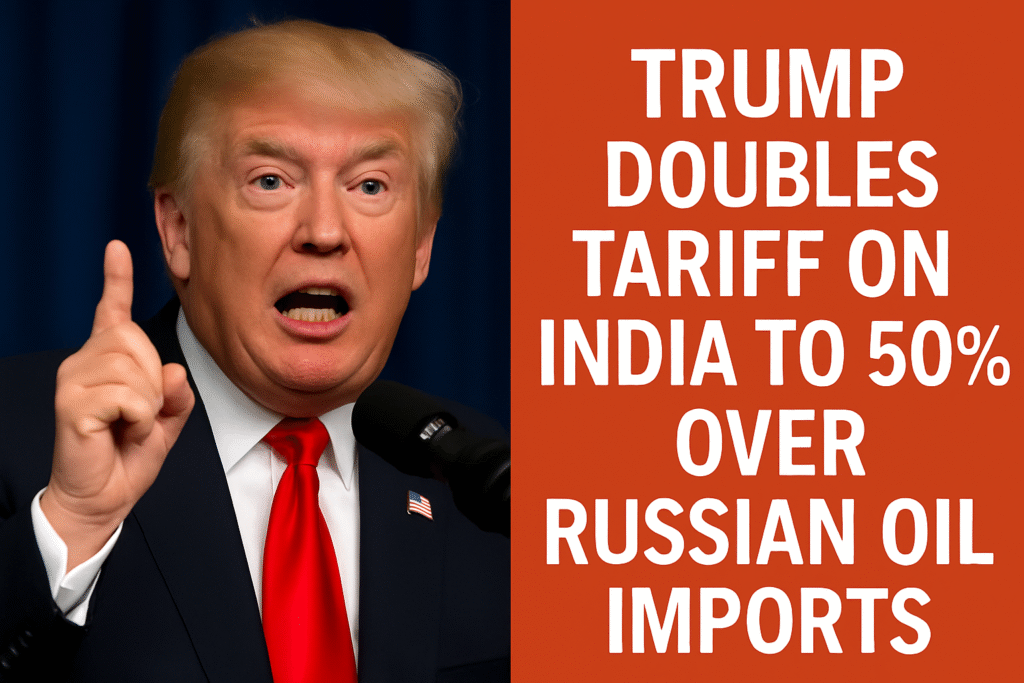
In a bold move that may redefine the trajectory of India–US trade ties, US President Donald Trump has signed an executive order doubling tariffs on Indian imports to 50%, citing India’s continued oil trade with Russia as a “strategic contradiction.” The White House confirmed this action on Wednesday, triggering widespread reactions across global markets and diplomatic circles.
“India has not been a good trading partner because they do a lot of business with us, but we don’t do business with them. So we settled on 25 per cent, but I think I’m going to raise that rate quite substantially in the next 24 hours,”– Donald Trump, in an interview with CNBC.
Within hours of that interview, the White House published the executive order referencing key legal authorities:
- International Emergency Economic Powers Act (IEEPA)
- National Emergencies Act
- Trade Act of 1974, Section 604
- Section 301 of Title 3, U.S. Code
This makes the tariff legally binding and enforceable, affecting a wide array of Indian exports—from textiles, pharma, and auto parts to IT services and agricultural goods.
🇮🇳 India Responds: “Unfair, Unjustified, Unreasonable”
India’s Ministry of External Affairs (MEA) was quick to respond, stating:
“This move is unfair, unjustified, and unreasonable—especially given the deep strategic and economic partnership India shares with the United States.”
New Delhi has not yet retaliated with counter-tariffs but is reportedly reviewing all options through the Ministry of Commerce and Industry, while keeping diplomatic channels open.
🔍 The Russia Oil Factor: Trigger for Trade Retaliation
The core of this escalation lies in India’s ongoing purchase of discounted Russian oil—a practice Washington sees as undermining its sanctions regime against Moscow. However, India defends the decision as a matter of national energy security and strategic neutrality.
The Trump administration, however, views it differently.
“If you buy oil from a country we’re trying to isolate, don’t expect a free trade pass,” said a White House trade advisor during a press briefing.
📉 Sectoral Impact: Which Indian Industries Are at Risk?
The 50% tariff is expected to ripple across several major export sectors:
| Sector | Impact Summary |
| Pharmaceuticals | Generics and APIs face reduced competitiveness in U.S. market |
| Textiles & Apparel | One of the hardest-hit; pricing pressure from new tariffs |
| Gems & Jewelry | Higher duty may reduce U.S. demand |
| IT Services | Indirect impact via reduced outsourcing or visa-related hurdles |
| Agricultural Exports | Especially almonds, rice, and spices at risk |
📈 Markets have reacted swiftly. The Economic Times reports significant drops in FMCG and IT stock indices following the tariff news.
🏛️ What Happens to the US-India Trade Deal Now?
Before this escalation, the Biden administration had made progress toward a revamped US-India trade deal, including:
- Restoration of GSP benefits
- Lower duties on pharma, textiles, and electronics
- Fairer treatment for Indian service exports
But with Trump signaling a return, the entire framework may be scrapped or reworked to align with his MAGA (Make America Great Again) agenda. His team has openly hinted at revisiting all trade agreements in favor of American workers.
🇮🇳 Modi Government’s Strategy: Calm, Calculated, Cautious
Prime Minister Narendra Modi’s administration is expected to:
- Strengthen domestic resilience under Make in India and PLI schemes
- Negotiate smartly to prevent further economic fallout
- Leverage multilateral forums like BRICS and G20 to build global consensus
Experts argue India should also look to expand trade with the EU, ASEAN, and Gulf nations to reduce U.S. dependency.
🚨 BIG! On Trump’s 50% tariff on India, PM Modi says: "For us, the interest of our farmers is TOP priority. India will NEVER compromise on the interests of farmers, fishermen & dairy farmers."
— Megh Updates 🚨™ (@MeghUpdates) August 7, 2025
"I know we'll have to pay a HEAVY price — but I am READY for it. India is ready." 🇮🇳 pic.twitter.com/1suAPhP8lN
🧾 Legal & Diplomatic Ramifications
Trump’s executive order derives authority from emergency trade powers, which are rarely used for democratic allies like India. This could set a precedent for economic coercion through trade policy, undermining long-standing norms in bilateral diplomacy.
The full order is available on the official White House website.
🧠 Conclusion: Are Tariffs the New Fae of Trump’s Foreign Policy?
With U.S. elections looming, Trump’s aggressive trade rhetoric is as much political as it is economic. But for India, this means preparing for strategic uncertainty:
- Will Trump’s second term be defined by tariffs and economic leverage?
- Can India defend its autonomy without alienating key allies?
- Is the U.S. still a reliable trade partner?
One thing is certain: India must balance global partnerships with national interest, or risk being caught in the crossfire of a new trade war..

